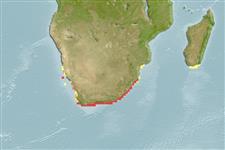>
Mugiliformes (Mullets) >
Mugilidae (Mullets)
Etymology: Pseudomyxus: Name from the genus Myxus preceeded by Greek prefix 'pseudo' meaning 'false'..
More on author: Valenciennes.
Environment: milieu / climate zone / depth range / distribution range
Ekologi
laut; air tawar; payau dasar (demersal); katadromus (ruaya dari air tawar ke laut) (Ref. 51243). Subtropical; 25°S - 35°S
Africa: endemic to South Africa, in east coastal estuaries and rivers from the Breë River to Kosi Bay (Ref. 7248, 52193).
Length at first maturity / Size / Weight / umur
Maturity: Lm 23.0 range ? - ? cm
Max length : 45.0 cm FL jantan/; (Ref. 52193)
Duri punggung (Keseluruhan (total)): 5; duri punggung lunak (Keseluruhan (total)): 8; Duri dubur 3; Sirip dubur lunak: 9.
Adults occur in freshwater to estuarine conditions. Adults breed at sea, throughout the year; juveniles move into estuaries and enter rivers usually in late winter or early spring (Ref. 52193). Females remain in freshwater for 7 years, males for 4 years (Ref. 52193). Return to estuaries before maturing sexually prior to spawning (Ref. 52193). Oviparous, eggs are pelagic and non-adhesive (Ref. 205). Feed on benthic algae and small invertebrates over muddy bottom (Ref. 6465). Decline in population from obstruction, by dams and weirs, of free passage into rivers.
Life cycle and mating behavior
Kematangan | Reproduksi, perkembang biakan | Pemijahan | telur-telur | Fecundity | Larva
Breed at the sea throughout the year. Juveniles move into estuaries and enter rivers usually in late winter or early spring. Males remain in freshwater until 4 years, females for up to 7 years. Fish return first to estuaries before maturing sexually prior to spawning (Ref. 7248).
Thomson, J.M., 1986. Mugilidae. p. 344-349. In J. Daget, J.-P. Gosse and D.F.E. Thys van den Audenaerde (eds.) Check-list of the freshwater fishes of Africa (CLOFFA). ISNB, Brussels, MRAC; Tervuren; and ORSTOM, Paris. Vol. 2. (Ref. 3573)
Status IUCN Red List (Ref. 130435)
ancaman kepada manusia
Harmless
penggunaan manusia
Perikanan: komersial; Akuarium: Komersial
informasi lanjut
AcuanBudidaya airprofil budidaya airStrainGenetikaElectrophoresesDiturunkanPenyakit-penyakitPengolahanNutrientsMass conversion
mitraGambarStamps, Coins Misc.Suara-suaraCiguateraKecepatanTipe renangArea insangOtolithsOtakPenglihatan / visi
Alat, peralatan
laporan khas
muat turun XML
Sumber internet
Estimates based on models
Preferred temperature (Ref.
123201): 15.3 - 24.9, mean 22.6 °C (based on 20 cells).
Phylogenetic diversity index (Ref.
82804): PD
50 = 1.0000 [Uniqueness, from 0.5 = low to 2.0 = high].
Bayesian length-weight: a=0.01175 (0.00668 - 0.02065), b=2.96 (2.81 - 3.11), in cm total length, based on LWR estimates for this species & (Sub)family-body (Ref.
93245).
Trophic level (Ref.
69278): 2.8 ±0.27 se; based on food items.
Daya lenting (Ref.
120179): sedang, Waktu penggandaan populasi minimum 1.4 - 4.4 tahun (Preliminary K or Fecundity.).
Fishing Vulnerability (Ref.
59153): Moderate vulnerability (40 of 100).
